|
Publications parues aux presses du CEAlex
Commercial amphoras in the Graeco-Roman Museum of Alexandria, A.K. Şenol
Lexicon of Eponym Dies on Rhodian Amphora Stamps, vol.4, Gonca Cankardeş-Şenol
Lexicon of Eponym Dies on Rhodian Amphora Stamps, vol.3, Gonca Cankardeş-Şenol
Lexicon of Eponym Dies on Rhodian Amphora Stamps, vol.2, Gonca Cankardeş-Şenol
Lexicon of Eponym Dies on Rhodian Amphora Stamps, vol.1, Gonca Cankardeş-Şenol
Timbres amphoriques de Pamphylie, Claude Brixhe, avec la collaboration de Gonca Cankardeş-Şenol, 2012
Amphores égyptiennes, Delphine Dixneuf, 2011
|
 |
Commercial amphoras in the Graeco-Roman Museum of Alexandria
A.K. Şenol
Études Alexandrines 44,
Centre d'Études Alexandrines,
Alexandrie, 2018
ISBN 978-2-490128-00-6 , ISSN 1110-6441 |
Excavations undertaken in Alexandria, one of the leading cities in Mediterranean trade during the Hellenistic period, have resulted in a relatively large amount of amphora finds. Five hundred and eighty-eight complete or nearly complete amphorae dating from the beginning of the Hellenistic period to the 7th century ad, of which 457 have been selected for presentation here, are held in Alexandria’s Graeco-Roman Museum and stand as concrete evidence of the commercial networks of the city. Rhodian, Cnidian, Coan, Chian, Mendean, Thasian and Lesbian goods reached Alexandria during the Hellenistic period, as well as goods from Tripolitania, Carthage, the Italian peninsula, Crete, Cyprus and other eastern Mediterranean centres. Under the Pax Romana, commercial activities between Mediterranean cities increased. As a result, many amphorae found in Alexandrian excavations are evidence of Italian, Baetican and Lusitanian trade. Commercial routes then shifted to north and south with the establishment of the new imperial capital in 330 ad. Alexandria provided her needs mostly from eastern Mediterranean centres, especially from the Gazan region in LR 4 amphorae and Cilicia in LR 1 amphorae after the end of the 4th century until the Arab invasion. However, alongside the continued commercial links with Aegean islands and the Italian peninsula, amphora production in Alexandria increased during the imperial period with eventual mass production after the 4th century. This work has enjoyed the financial support of the Union Académique Internationale. |
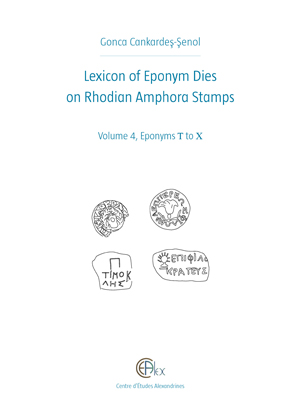 |
Lexicon of Eponym Dies on Rhodian Amphora Stamps, vol. 4, Eponyms T to X
Gonca Cankardeş-Şenol
Études Alexandrines 39,
Centre d'Études Alexandrines,
Alexandrie, 2017
ISBN 978-2-11-139025-6 , ISSN 1110-6441 |
This fourth volume completes our publication of eponym dies on Rhodian amphora stamps. The volume contains 670 matrices belonging to 34 eponyms. The total in all four volumes of the series represents 5,772 matrices for 259 eponyms. We have been informed of previously unpublished matrices and we would like to thank our contributors. These new examples will be included in a volume of addenda et corrigenda, which will be published after the four forthcoming volumes of the lexicon of fabricant dies on Rhodian amphora stamps, the first of which is planned for 2018.
This new series will hold more than 4,257 dies belonging to 456 different fabricants who worked over 259 years, that is, the total number of annual eponyms. Thus, we know that the total of all different matrices on amphora.
Dr Gonca Cankardeş-Şenol is a professor in the Department of Archaeology, Ege University, Izmir, Turkey and a specialist in Eastern Mediterranean amphora stamps. She has published numerous works on amphora stamps found in sites of Anatolia, Rhodian Peraea and especially in Egypt. She has identified more than 10,000 Rhodian dies which can be consulted on this website |
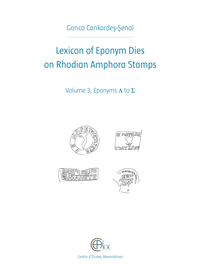 |
Lexicon of Eponym Dies on Rhodian Amphora Stamps, vol. 3, Eponyms Λ to Σ
Gonca Cankardeş-Şenol
Études Alexandrines 37,
Centre d'Études Alexandrines,
Alexandrie, 2016
ISBN 978-2-11-139024-9 , ISSN 1110-6441 |
This work is the third in a four-volume lexicon of eponym dies stamped on Rhodian amphorae. It contains 1443 matrices designating 60 eponyms whose names begin with the Greek letters Lambda through Sigma. This volume represents a continuation of the matrix studies that began in 2003 in the rich Alexandrian collections of the Graeco-Roman Museum, particularly the Benaki Collection, and in finds from Alexandria excavations. The volume contains also stamps from excavations of Crocodilopolis/Arsinoe and other sites in Egypt as well as Delos island and some previously published stamps from excavations sites in other Eastern Mediterranean consumption centres.
In the matrix names, numbers do not refer to any chronological dating order. Under the title of each eponym, following some brief information (the eponymous year of the eponym, total number of matrices naming him, used/not-used month names and the names of the producers associated with him) the stamps naming him are presented, beginning with the dies accompanied by month-names (if applicable) in alphabetical order, followed by the dies without month names.
In the forthcoming fourth volume, appendices will contain Addenda et corrigenda as well as lists with eponym-producer and producer-eponym associations in alphabetical and chronological order. Additional lists will refer to matrices of eponyms accompanied by fabricant matrices seen on the same amphorae and the matrices of secondary stamps accompanying the eponym dies. |
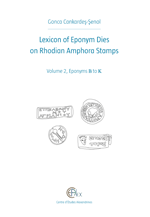 |
Lexicon of Eponym Dies on Rhodian Amphora Stamps, vol. 2, Eponyms B to K
Gonca Cankardeş-Şenol
Études Alexandrines 35,
Centre d'Études Alexandrines,
Alexandrie, 2015
ISBN 978-2-11-139023-2 , ISSN 1110-6441 |
This work is the second in a four-volume lexicon of eponym dies stamped on Rhodian amphorae. It contains 1,550 matrices designating 78 eponyms whose names begin with the Greek letters Beta through Kappa. This volume represents a continuation of the matrix studies that began in 2003 in the rich Alexandrian collections of the Graeco-Roman Museum, particularly the Benaki Collection, and in finds from excavations. The volume contains stamps from excavations of Delos, Crocodilopolis/Arsinoe and other sites in Egypt as well as some previously published stamps from excavations sites in other Eastern Mediterranean consumption centres. In the matrix names, numbers do not refer to any chronological dating order. Under the title of each eponym, following some brief information (the eponymous year of the eponym, total number of matrices naming him, used/not-used month names and the names of the producers associated with him) the stamps naming him are presented, beginning with the dies accompanied by month-names (if applicable) in alphabetical order, followed by the dies without month names.
In the fourth volume, appendices will contain lists with eponym-producer and producer-eponym associations in alphabetical and chronological order. Additional lists will refer to matrices of eponyms accompanied by fabricant matrices seen on the same amphorae and the matrices of secondary stamps accompanying the eponym dies.
Dr GONCA CANKARDEŞ-ŞENOL is a professor in the Department of Archaeology, Ege University, Izmir, Turkey and a specialist in Eastern Mediterranean amphora stamps. She has published numerous works on amphora stamps found in sites of Anatolia, Rhodian Peraia and especially in Egypt. She has identified more than 10,000 Rhodian dies which can be consulted on the website <www.amphoralex.org>. |
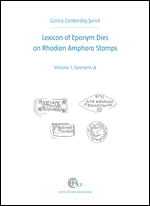 |
Lexicon of Eponym Dies on Rhodian Amphora Stamps, vol. 1, Eponyms A
Gonca Cankardeş-Şenol
Études Alexandrines 33,
Centre d'Études Alexandrines,
Alexandrie, 2015
ISBN 978-2-11-139022-5 , ISSN 1110-6441 |
Throughout the Hellenistic Period, from the late 4th to the middle of the 1st century BC, more than 500 producers in Rhodes and the Peraea produced amphorae for transporting Rhodian wine. As an indication that this activity was controlled by the state, they stamped their jars with dies bearing their names and the names of the eponyms who were chosen for one year from among the priests of Helios. The Rhodian amphora stamps found in the archaeological excavations of various consumption centres have been gradually published since the second half of the 19th century and today the number of such items is enormous. This volume contains different dies bearing the names of more than 200 eponyms and is based on the studies of matrices which began in 2003 in the rich Alexandrian collections of the Graeco-Roman Museum, especially the Benaki Collection, and in finds from excavations. Some 5,774 dies presented here are from the Alexandrian collections and from archaeological excavations in the city. In addition, the volume contains stamps from excavations of Delos, Crocodilopolis/Arsinoe and other sites in Egypt and some previously published stamps from excavations sites in other Eastern Mediterranean consumption centres. We have established 1,098 eponym-producer associations by means of both published complete amphorae and possible pairs and also stylistic studies of stamps. The stamps are presented in the alphabetical order of the eponyms after a short history of stamp studies and an explanation of matrix studies. In the matrix names, numbers do not refer to any chronological dating order. Under the title of each eponym, following some brief information (the eponymous year of the eponym, total number of matrices naming him, used/not-used month names and the names of the producers associated with him) the stamps naming him are presented, beginning with the dies accompanied by month-names (if applicable) in alphabetical order followed by the dies without month names. In the appendices there are lists containing eponym-producer and producer-eponym associations in alphabetical and chronological order. Additional lists refer to matrices of eponyms accompanied by fabricant matrices seen on the same amphorae and the matrices of secondary stamps accompanying the eponym dies.
Dr GONCA CANKARDEŞ-ŞENOL is a professor in the Department of Archaeology, Ege University, Izmir, Turkey and a specialist in Eastern Mediterranean amphora stamps. She has published numerous works on amphora stamps found in sites of Anatolia, Rhodian Peraia and especially in Egypt. She has identified more than 10,000 Rhodian dies which can be consulted on the website <www.amphoralex.org>. |
|
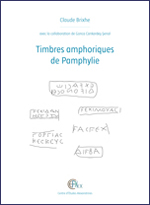 |
Timbres amphoriques de Pamphylie
Claude Brixhe
avec la collaboration de Gonca Cankardeş-Şenol
Études Alexandrines 23,
Centre d'Études Alexandrines,
Alexandrie, 2012 |
This collection represents the completion of an endeavour begun more than half a century ago by A.G. Woodhead. If Pamphylia has been one of the last provinces to be covered by amphorology, that is because its stamps bear neither ethnic nor symbol nor indication of function, but only one, two or (very rarely) three anthroponyms. Thus their identification is difficult; when identification is certain this rests upon the alphabet used, the phonetics or the morphology of the name. One can find here some 763 stamps, from the late Hellenistic period, coming essentially from Alexandria and its region: Pamphylia itself furnishes only a few examples. Their presentation is accompanied by a photo of the document, a rubbing and a drawing which allow one to follow the critical approach. This corpus undoubtedly raises questions to which there are presently no answers (number of workshops, cities involved etc.), just as it confirms the prodigious originality of name-giving in this society that was the result of an on-going osmosis over a millennium between local populations and Greeks of diverse origins.
Ce recueil représente l’aboutissement d’un travail initié il y a plus d’un demi-siècle par A.G. Woodhead. Si la Pamphylie est une des dernières provinces à être touchées par l’amphorologie, c’est que ses timbres ne comportent ni ethnique, ni symbole, ni indication de fonction, mais seulement un, deux ou (très rarement) trois anthroponymes. Leur identification est donc difficile ; quand elle est assurée, elle repose sur l’alphabet utilisé, la phonétique ou la morphologie des noms. On trouvera là environ 763 timbres, de basse époque hellénistique, provenant essentiellement d’Alexandrie et de sa région, la Pamphylie elle-même n’en fournissant que quelques-uns. Leur présentation est accompagnée d’une photo du document, d’un frottis et d’un dessin, qui permet de suivre l’apparat critique. Ce corpus soulève certes des questions actuellement sans réponse (nombre d’ateliers, cités concernées, etc.) ; il n’en confirme pas moins la prodigieuse originalité de l’onomastique d’une société faite d’osmoses successives, réparties sur un millénaire, entre populations indigènes et Grecs d’origines diverses.
Claude Brixhe, correspondant de l’Institut, est professeur émérite à l’Université de Nancy 2. Il est spécialiste de l’histoire des alphabets grecs ou apparentés, de certaines langues micrasiatiques (phrygien, pisidien, sidétique), mais surtout des dialectes grecs, notamment de celui de Pamphylie, auquel il a consacré un ouvrage, Le dialecte grec de Pamphylie. Documents et grammaire, Paris, 1976, suivi de plusieurs suppléments. |
|
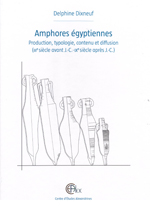 |
Amphores égyptiennes
Production, typologie,contenu et diffusion
(IIIe siècle avant J.-C. - IXe siècle après J.-C.)
Delphine Dixneuf
Études Alexandrines 22,
Centre d'Études Alexandrines,
Alexandrie, 2011 |
Thanks to archaeological research conducted over the past decade in Egypt, many amphora groups of Egyptian origin have been discovered and dated from the Hellenistic period to the beginning of the Arab period. It is from this hitherto unpublished material and the archaeological contexts of four sites, Alexandria, Buto (Western Delta), Pelusium (Tell el-Makhzan, Tell el-Farama in North Sinai) and Bawit, next to the vineyards of Middle Egypt, that it has been possible to draw up a typological and a chronological evolution of Egyptian amphorae. The questions of origin determination, by identification of workshops and macroscopic examination of clays, as well as the typo-chronology based on contexts analysis, are the major themes of the study. These different research fields have led the author to consider the conditions of amphorae production, the contents, commercial exchanges and distribution channels not only in Egypt but also in the Mediterranean basin.
Les recherches archéologiques conduites ces dix dernières années en Égypte ont livré plusieurs ensembles amphoriques représentatifs de la production égyptienne, de la période hellénistique au début de l’époque arabe. C’est à partir de ce matériel inédit et des contextes archéologiques de quatre sites, Alexandrie, Bouto (Delta occidental), Péluse (Tell el-Makhzan, Tell el-Farama au nord du Sinaï) et Baouit au cœur des vignobles de Moyenne-Égypte, qu’il a été possible d’esquisser un schéma de l’évolution typologique et chronologique des amphores égyptiennes. La question de la détermination des provenances, par l’identification des ateliers de production et l’examen macroscopique des pâtes, ainsi que la typo-chronologie basée sur l’analyse des contextes, constituent les thèmes majeurs de cette étude. Ces différents champs de recherche ont conduit l’auteur à une réflexion sur les conditions de la production, la nature des contenus, les échanges commerciaux et les circuits de distribution des denrées et marchandises non seulement en Égypte mais également sur le pourtour du bassin méditerranéen. |
| |
|
These books can be bought in Egypt in the "Centre d'Études Alexandrines".
For the other contries : De Boccard Édition-Diffusion, 4 rue de Lanneau, 75005 PARIS, France -<www.deboccard.com> |
Ces ouvrages peuvent être achetés en Égypte au Centre d'Études Alexandrines.
et pour les autres pays auprès de De Boccard Édition-Diffusion, 4 rue de Lanneau, 75005 PARIS, France -<www.deboccard.com> |
|









